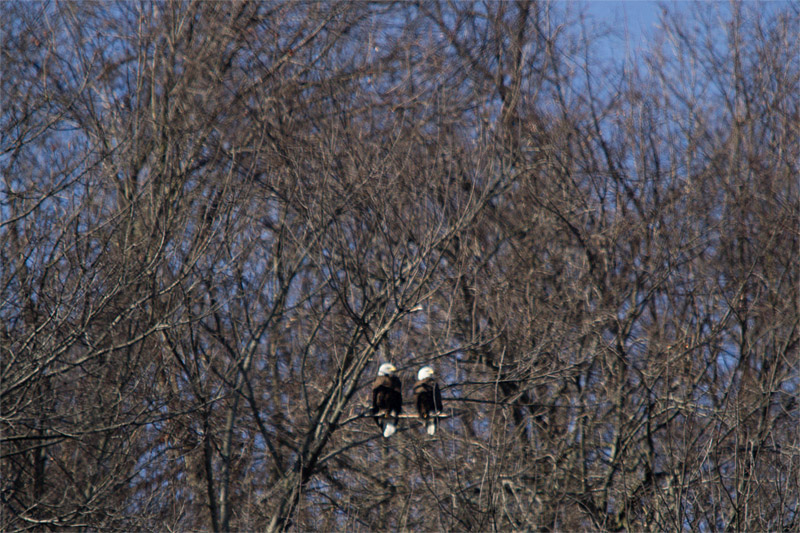People just can’t seem to get enough of bald eagle webcams. In Pittsburgh, they’ve often become the source of high drama — like, for instance, last year when one of the city’s bald eagle pairs brought a domestic cat back to the nest to feed their eaglets in full view of the webcam.
Then, last weekend, Pittsburghers watched another intense storyline play out: A big wind storm blew over the giant Hackberry tree where the pair of eagles in the city’s Hays neighborhood, along the Monongahela River, have nested for several years. Worse yet, there was a recently laid egg in the nest at the time.
LISTEN: Pittsburgh’s Bald Eagles in Rebuilding Mode
Jim Bonner, executive director of the Audubon Society of Western Pennsylvania, was on the scene the next day. His organization monitors the eagles with the Pennsylvania Game Commission and Pixcontroller, Inc. which operates the camera.
“You could basically see nothing,” Bonner says. “Where there had been a tree, it wasn’t there anymore. We weren’t there more than a few minutes when both birds did come flying overtop. They circled around the area where the tree had been and continued to move up and down the river.”
But he says the egg probably wasn’t so lucky.
“We have to assume that it was broken,” Bonner says. “The area is rather inaccessible, so there was not a search of the ground. But falling 50 or 60 feet, you’d have to expect an egg to break on impact.”
And there was more bad news. They were expecting the female to lay another egg. He says usually the eagles lay them two to three days apart. Without a nest, though, Bonner says she likely “expelled” the egg somewhere else.
Bonner fully expects the eagles to stick around and build another nest. The site has all the food, water and protection they need to thrive. And losing a nest, in fact, is nothing the eagles haven’t been through before. A previous nest was knocked down a few years ago. That time, a chick was in it, and the eagles reared it from a new spot and rebuilt the old nest later. In fact, in recent days, the Hays eagles have been spotted bringing twigs and branches to a new tree, near where their old tree fell.
“Eagles will continue to add and build on their nest for as long as the nest exists,” Bonner says. “So year after year, they bring in more sticks and they become quite large. Some have gotten up to 2,000 pounds.”
Bonner says it might just take them a couple of weeks to weave a new nest that’s suitable for raising young. Bald eagles actually perform courtship rituals and mating all year long, in bonded pairs, and nest building helps reinforce their relationships. But this is the only time of year when their hormones take over and the females are fertile. Some good news for eagle watchers: The Hays pair was at it a little bit early this year.
“Based on past years, we were still thinking it was about one to two weeks before we would see the first egg. And if we go back over the past five years, previously it was towards the middle of March. So there’s still plenty of time for them to have a successful season.”

A Pennsylvania bald eagle looks after a duo of young eaglets. In recent years, bald eagles have returned to the Pittsburgh region, mostly due to improved water quality. Photo: Hal Korber / Pennsylvania Game Commission
The Hays pair is one of two bald eagle couples near Pittsburgh you can watch via webcam. It’s only been in recent years that eagles have moved back into the area, mostly due to improving water quality.
“They are dependent on our water quality, and the fish that they feed on and feed their young. And although water quality in western Pennsylvania is vastly improved from where it was 30 years ago, there still are some challenges.”
Bonner says eagles are also at risk of “secondary poisoning” from rat killers used on the animals they prey on. And sometimes people purposely poison or shoot bald eagles — either for sport or because they see them as a nuisance. Killing bald eagles is a federal crime.
As for eagle fans, Bonner says he understands why people find it hard to sit back when the eagles catch a tough break. But he says the cameras capture just one small example of the cycle of life and death that’s unfolding all around us.
“When we’re looking at it, we have to understand that that’s nature. That we’re best to keep hands off, as much as possible. We want to provide a clean and safe environment, but we don’t practice an interventionist approach. They’ve evolved over tens of thousands of years to know how to take care of their young. And as long as we kind of get out of their way — they’ll do well.”
###
UPDATE: February 20, 2017 — The Hays eagles have laid an egg in their new nest. Read the update from the Audubon Society of Western Pennsylvania here.


